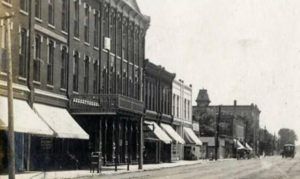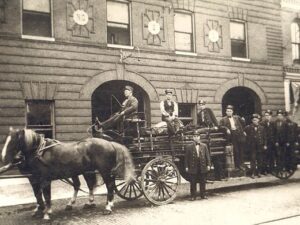
Getting To C-Street
Directions
Commercial Street, fondly referred to as C-Street by locals, is Springfield’s first Nationally Registered Historic District. City council recognized this designation on July 31, 1978. Historically significant structures are easily identified all throughout the district.
 In 1853 a transcontinental railroad was surveyed across the country with a proposed railroad line about 1.3 miles north of the Springfield Downtown Square. At this time, this area was called North Springfield. Merchants and nearby landowners worked hard to provide substantial incentives to bring the railroad North Springfield. Those incentives included a donation of a 200 ft wide right-of-way land, a 40 acre tract for railroad shops, and ½ ownership of a town to be plated on 200 acres adjacent to the railroad depot. Once the plans for the railroad began to settle in, Commercial Street, as we know it today, began to develop.
In 1853 a transcontinental railroad was surveyed across the country with a proposed railroad line about 1.3 miles north of the Springfield Downtown Square. At this time, this area was called North Springfield. Merchants and nearby landowners worked hard to provide substantial incentives to bring the railroad North Springfield. Those incentives included a donation of a 200 ft wide right-of-way land, a 40 acre tract for railroad shops, and ½ ownership of a town to be plated on 200 acres adjacent to the railroad depot. Once the plans for the railroad began to settle in, Commercial Street, as we know it today, began to develop.
A former employee of the Ozark Land Company, A.M Haswell, recorded the success of North Springfield in the Missouri Historical Review in 1925, “Commercial street, eighty feet wide, paralleled the railroad survey for three – quarters of a mile, and a long before the stimpts and rockets were cleared out of the roadway, scores of businesses building sprang up on either side. Residences too were built in wonderful numbers, and when in April 1979, the first train came in, there were nearly 400 permanent inhabitants in North Springfield, and more than thirty businesses houses.”
Once the railroad was in use there was an expansion and dramatic shift in the local economy.
In 1878, ten years after the first train came through, North Springfield had over 1,500 inhabitants and an impressive roster of business types including:
Three dry good stores, one of them a wholesale house, a wholesale and retails clothing store, two drugstores, one stove and tinware state, one large hardware and agriculture implement store and manufacturer, one book store, one boot and shoe store, sever retail groceries, three wheat elevators, a shipper of general agricultural products, one lumber yard, one tobacco factory, one watchmaker, three hotels, a weekly newspaper, and two brick yards.